MercoPress. South Atlantic News Agency
Tag: blue dollar
-
Saturday, January 18th 2014 - 06:39 UTC
US dollar approaching the 12 Pesos mark in Argentina
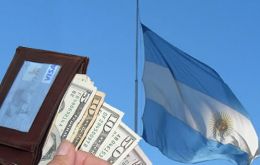
The US dollar in Argentina reached a new record on Friday at the end of nerve racking week which saw the greenback in the parallel market climb another 40 cents and close at 11.90 and 11.95 Pesos purchase and sale prices. During the week the US dollar soared 1.15 Pesos, and closed the week with a gap of 75.6% between the official dollar exchange and the 'blue' dollar.
-
Friday, January 17th 2014 - 08:05 UTC
US dollar keeps breaking records in Argentina; central banks reserves fall a further 100 million
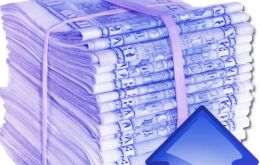
The US dollar reached a new record high on Thursday as purchase pressure on the so called “blue” or informal market continues pushing the price which closed 35 cents up at 11.50 pesos for buyers and 11.55 pesos for sellers.
-
Thursday, January 16th 2014 - 09:22 UTC
US dollar reaches new record in Argentina, 11.25 Pesos
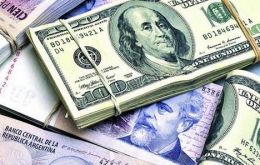
The US dollar in Argentina continued to climb on Wednesday and reached new highs both in the official market and in parallel trading or the 'blue market'. The official rate closed at 6.75 Pesos to the greenback while the 'blue' reached a record 11.25 Pesos (selling price) with a 66.5% gap between both markets.
-
Wednesday, January 8th 2014 - 05:00 UTC
US dollar climbs to new record in Argentina: 10.90 Pesos
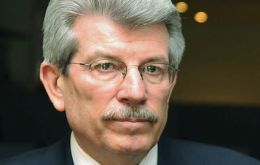
The newly appointed Argentine Central bank chairman Juan Carlos Fábrega strategy to make the money exchange markets converge does not seem to be working: on Tuesday the 'blue' or parallel dollar soared to a new record, 10.85 and 10.90 Pesos, while the gap with the official rate again climbed to almost 60%.
-
Wednesday, October 23rd 2013 - 01:36 UTC
US dollar in Argentina reached 10 Pesos ahead of Sunday's mid-term election
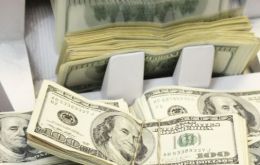
The US dollar in Buenos Aires reached on Tuesday 10 Argentine Pesos (buying price) and 10.05 pesos (selling price) in the informal market, 15 cents higher compared to its last closing price, pushed by the tourist sector, and as the government crackdown on the so called city “exchange caves” eased up.
-
Monday, October 21st 2013 - 21:30 UTC
Argentine Central bank losing reserves at a rate of 47.5 million dollars per day
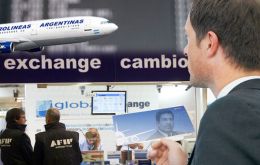
Argentina's central bank is currently losing international reserves at an average of 47,5 million dollars per day or 8 million per hour, according to the latest figures on the bank's accounts which is increasingly used by the government of President Cristina Fernandez to honor foreign debt and finance the budget.
-
Tuesday, May 14th 2013 - 06:49 UTC
Whitewashing draft bill and Moreno have US ‘blue’ dollar market in Argentina flat
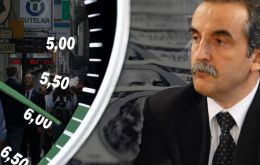
Trading of the ‘blue’ or parallel dollar in Argentina remained flat on Monday for a second day following last week’s events when the 10 Pesos barrier was broken and the government reacted with a tax amnesty or whitewashing draft bill promising all dollar assets holders a new clean record and no questions asked if they turn their greenbacks into government bonds or promissory notes.
-
Thursday, May 9th 2013 - 05:13 UTC
Do you trust this Lady to look after your dollar savings?

The administration of President Cristina Fernandez sent on Wednesday to congress the tax amnesty bill to tap undeclared dollar assets, in the country and overseas, generating a cascade of critical reactions from well known economists while the ‘blue dollar’ in the parallel market seemed to ignore the announcements and kept climbing to a new record high.
-
Thursday, May 9th 2013 - 05:05 UTC
Argentine official pledges to look into ‘blue’ dollar market and admits problems in real estate sector

Argentina Deputy Economy minister Axel Kicillof pledged “to look into” the growing parallel market for the US dollar because it is harming many innocent people who have nothing to do with speculation and claimed that ‘certain economists’ and media are encouraging speculation with the greenback.
-
Thursday, May 9th 2013 - 04:56 UTC
Argentina: Dollar kept climbing on Wednesday and reached 10.45 Pesos

Despite the tax amnesty bill and investment options pledged by the government of President Cristina Fernandez, the dollar kept climbing in Argentina. After breaking the key psychological barrier of 10 Pesos to the dollar on Tuesday, the “blue” dollar which trades on the parallel market climbed again on Wednesday another 37 cents to reach 10.45 Argentine Pesos.
